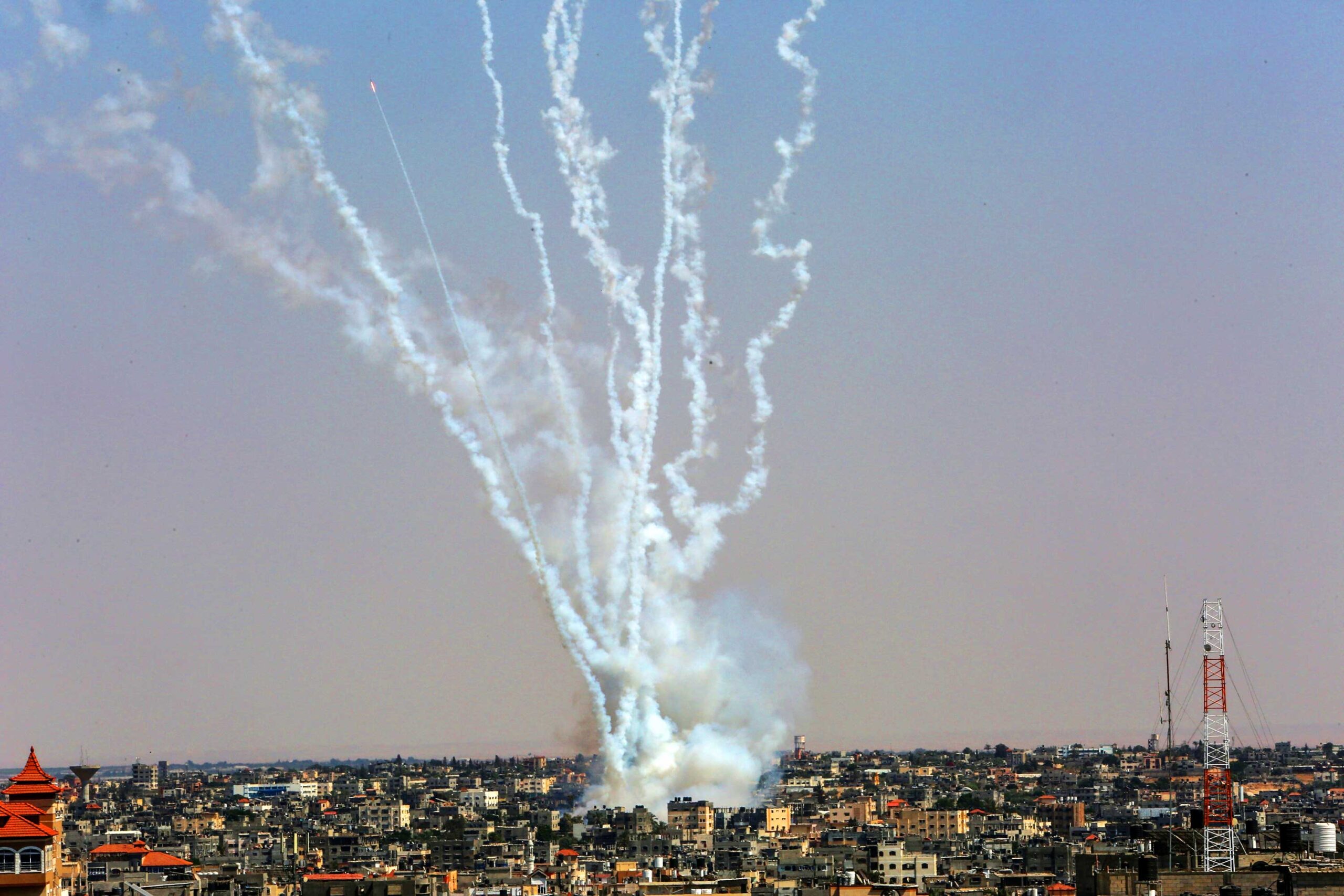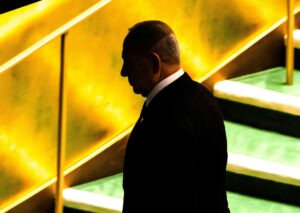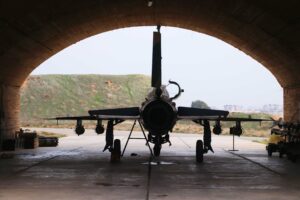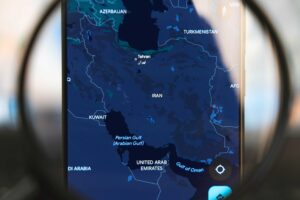The brutal terrorist attack and assault on Israel by jihadist group Hamas on October 7, with the group killing about 1,200 people and abducting 240, initiated the ongoing war with Israel.[i] Besides the intense combat first in southern Israel and now in Gaza, the war has featured an active periphery in Lebanon, Syria, the West Bank, and even Iraq and Yemen. Created and cultivated by the Islamic Republic of Iran, the “axis of resistance” is a collection of Iran-sponsored organizations across these territories whose goal is to expand Iranian influence and destroy Israel.[ii] Hamas, Palestinian Islamic Jihad, and other Gaza-based groups are one of these—Lebanese Hezbollah; Yemeni Ansarallah (or the Houthis); and the Iraqi militias Badr, Kataib Hezbollah, Asaib Ahl al-Haq, Harakat al-Nujaba, and others comprise additional nodes of the axis.[iii]
All back Hamas in the war and have taken different militant actions to support it. This article reviews the various approaches these groups have taken to impact the conflict, starting from the center of the war in Gaza before examining other theaters. Although Iran enables these groups, it has received the least attention, and the United States and its allies should take greater efforts to counter the Islamic Republic as the threat it poses grows.
Hamas aims to set the region ablaze
At the center of this war is Hamas, which ignited the fighting when it attacked Israel, thereby shattering the ceasefire earlier concluded with Israel in 2021.[iv] Evidence recovered from the battlefield suggests Hamas sought to rapidly occupy significant swathes of territory in southern Israel while sparking an uprising by Arabs in the Israeli-controlled West Bank and inside Israel’s sovereign borders.[v] It also hoped for Hezbollah to join the war and open a northern front against Israel.[vi] Hamas and other Gazan terrorist groups, per the Israel Defense Forces (IDF), deployed at least 3,000 heavily armed operatives to break through the Israeli border fence via ground vehicle, paraglider, and boat and storm communities as far as 25 kilometers deep into Israeli territory.[vii] In tandem, it fired a massive salvo of 3,000 rockets to overwhelm Israeli defenses.[viii] The group exploited its gains to commit atrocities against residents of the border communities, but its early success and gruesome actions did not foment an Arab rebellion, and Israel has so far effectively addressed heightened terrorist activity largely instigated by Hamas activists in the West Bank.[ix] The IDF took several days to defeat the attackers and mount a counteroffensive.
Hamas shifted to a strategy of territorial defense, particularly in urban centers.
Confined back into Gaza without another major front opened, Hamas shifted to a strategy of territorial defense, particularly in urban centers, likely aiming to break Israeli will to continue the war. Here, Hamas’s massive tunnel network under Gaza – that the group claims runs 300 miles and goes up to 20 stories deep – features prominently, enabling its fighters to move concealed and avoid IDF airstrikes, armor, and artillery, while also ambushing advancing Israeli units from hidden shafts.[x] At the same time, the group bases rockets, small arms and explosives, operatives, and other assets in civilian residences and neighborhoods, using civilians as human shields to complicate IDF operations.[xi] It also uses the hostages it took on October 7 as leverage to pressure Israel into slowing or stopping its operations. In addition, Hamas calls for sympathizers to “rise up” abroad[xii] and plots terrorist attacks in the West to apply further pressure.[xiii]
Overall, following a failed offensive military strategy aiming to squeeze Israel on multiple fronts, Hamas has retreated to a defensive one seeking to inflict pain on advancing Israeli forces and turn international opinion against it to compel an end to the IDF counteroffensive. Hamas’s current approach harks back to what retired Israeli general Itai Brun called the “Other RMA” (revolution in military affairs) – a “way of war” pioneered by Iran and Hezbollah that emphasizes absorbability and survivability to win the “war by not losing it.”[xiv] The current war now tests this approach as Israel has stated that its goal is to dismantle Hamas in Gaza and appears willing to pay a considerable price to achieve it.
Hezbollah keeping the IDF busy in the north
Iran’s oldest proxy, Lebanese Hezbollah is better-equipped, stronger, and larger than Hamas. Hezbollah boasts an arsenal of up to 150,000 rockets, several-fold that of Hamas,[xv] and, according to a 2016 report by Haaretz newspaper, a force of at least 21,000 full-time fighters and a similar number of reservists.[xvi] The group benefitted from years of Iranian tutelage and generous funding, as well as combat experience over insurgency and war with Israel and in the Syrian Civil War.[xvii] Hezbollah has hosted Hamas in Lebanon and trained some of its fighters, with the October 7 attacks largely resembling a Hezbollah operational plan uncovered in 2012 to seize northern Israel.[xviii]
Hezbollah has proven reluctant to fully enter the war, content to instead engage in smaller-scale attacks along the Israel-Lebanon border to keep the IDF preoccupied.
Despite Hamas’s hopes and Hezbollah’s strength, the latter has proven reluctant to fully enter the war, content to instead engage in smaller-scale attacks along the Israel-Lebanon border to keep the IDF preoccupied. Hezbollah leader Hassan Nasrallah has taken credit for tying up “one-third” of the IDF in the north, a signal from Hezbollah to its audience that its current activities are sufficient.[xix] Although Hezbollah has probably not significantly impacted the direction of the war in Gaza, it has conducted enough continuous rocket, antitank missile, and shooting attacks to prompt the evacuation of dozens of northern Israeli border communities comprising tens of thousands of people.[xx] This does impose costs on Israel as it has had to allocate significant resources to supporting the approximately 200,000 people displaced from the south and north due to the war.[xxi] Israel has demanded Hezbollah withdraw its forces from the Lebanese border and also pursued diplomatic efforts to get it to do so.[xxii] This situation remains unacceptable to Israel, and the likelihood of escalation rises as it carries on unresolved.[xxiii]
Still, Hezbollah has paid a price even for these limited activities. Israeli retaliatory strikes have killed more than 150 Hezbollah members so far.[xxiv] Watching events unfold in Gaza, where the IDF claims it has killed at least 8,000 Hamas members,[xxv] and American aircraft carriers move to the Mediterranean, Hezbollah is likely fearful of what might befall it should it decide to escalate.[xxvi] If true, reports that in November, Iranian supreme leader Ali Khamenei told Hamas political bureau chairman Ismail Haniyeh that Iran would not join the war further suggest that Hezbollah will not escalate.[xxvii] Thus, Hezbollah will likely continue to harass IDF positions along the border to keep Israeli forces preoccupied.
Testing American and international resolve from Iraq and Yemen
The Washington Institute for Near East Policy have counted 144 rocket, drone, and mortar attacks on U.S. bases in Iraq and Syria since October 18 claimed by Iran-backed Iraqi militias.
Iran’s proxy groups in Iraq and Yemen have also expressed solidarity with Hamas and tried to dampen international support for Israel. Experts from The Washington Institute for Near East Policy have counted 144 rocket, drone, and mortar attacks on U.S. bases in Iraq and Syria since October 18 claimed by Iran-backed Iraqi militias.[xxviii] On October 10, Badr militia leader Hadi al-Ameri threatened to attack “all U.S. targets” should the United States “intervene in the battle with Hamas.”[xxix] On October 24, a group affiliated with the Kataib Hezbollah militia threatened to attack U.S. forces in the United Arab Emirates and Kuwait.[xxx]
While the militias have kept a steady pace of strikes on American bases (ceasing only briefly in adherence to the Israel-Hamas truce in late November), they have not affected U.S. support for Israel. In fact, the United States has remained firmly behind Israel in the war.[xxxi] At the same time, U.S. forces must be on heightened alert in case the militias seek to escalate attacks and U.S. retaliation against militias in Iraq has brought up tensions with the Iraqi government, which condemned a November 22 strike that killed eight Kataib Hezbollah members as a “dangerous escalation.”[xxxii] A day after a January 4 U.S. retaliatory strike in Baghdad that a killed senior Harakat al-Nujaba militia operative, Prime Minister Mohammed Shia al-Sudani announced his government’s intention to have U.S. forces withdraw from Iraq.[xxxiii]
The Houthis fired at least two ballistic missiles at Israel, a threat Israel has not faced since Iraq under Saddam Hussein.
The Houthis, from their territory in north Yemen, have fired long-range missiles at southern Israel and attacked commercial shipping off the Yemeni coast. With important exceptions, these strikes have had little material impact, and U.S. warships and even Saudi air defenses intercepted some of the missiles and drones approaching Israeli territory.[xxxiv] At the same time, while failing to cause damage, the Houthis fired at least two ballistic missiles at Israel, a threat Israel has not faced since Iraq under Saddam Hussein launched Scud missiles at Israel in 1991.[xxxv] The group also shot down an American MQ-9 Reaper drone. Moreover, the Houthis have hit commercial vessels transiting the Red Sea with missiles and even conducted a heliborne hijacking of at least one cargo ship linked to Israel.[xxxvi] These attacks are adversely impacting global maritime trade, as large international corporations, such as BP,[xxxvii] have paused their Red Sea shipping operations in response to Houthi attacks and begun using the longer, more expensive Cape of Good Hope route.[xxxviii] To put this threat in perspective, the International Chamber of Shipping estimates that 12% of global maritime trade passes through the Red Sea.[xxxix]
Iran fueling the instability
Despite its pivotal role in arming, training, funding, and building these resistance axis groups, Iran has so far faced few consequences for its destabilizing actions in the current war. In fact, Iran has continued supporting them and, according to the International Atomic Energy Agency, has increased its production of near weapons-grade nuclear material.[xl] Israel has struck back at Hamas and Hezbollah while the United States did against militias in Iraq and formed a coalition of ten countries to confront the Houthi in the Red Sea.[xli] In contrast, Iran has thus far faced no serious retaliation, with the important exception of an apparent Israeli airstrike in Syria that killed a general in Iran’s elite Islamic Revolutionary Guard Corps (IRGC).[xlii]
The missiles and rockets these groups possess came from Iran, or the organizations learned how to manufacture their own under Iranian tutelage.
Iran must face consequences for the behavior of the groups it sponsors. The missiles and rockets these groups possess came from Iran, or the organizations learned how to manufacture their own under Iranian tutelage. Military training and weapons smuggling from Iran – handled by the IRGC – have enabled Hamas, Hezbollah, the Houthis, major Iraqi militias, and others to terrorize Israel, the United States, and its allies. Degrading these organizations is an important task, but they will continue to regenerate and pose major threats unless the Iranian regime suffers too.
There are several courses of action the United States and its allies can take to address the threat. First, it can get more comfortable operating in the “gray zone” against Iran, conducting sabotage, intelligence operations, or other actions short of war to inflict pain on the Islamic Republic.[xliii] Such operations might target IRGC assets or nuclear infrastructure inside Iran. Second, the United States can further tighten the sanctions regime against Iran and leverage hard-nosed diplomacy to bring more countries to compliance. These actions would send a clear message to Iran that it cannot continue with its malicious activity cost-free. Truly combating the “axis of resistance” means dismantling it from its head, not only attacking its arms.
[i] Daniel Byman et al., “Hamas’s October 7 Attack: Visualizing the Data” (Center for Strategic and International Studies, December 19, 2023), https://www.csis.org/analysis/hamass-october-7-attack-visualizing-data.
[ii] Arman Mahmoudian, “Hamas Is Only One of Four Iranian Fronts Against Israel,” Stimson Center, October 12, 2023, https://www.stimson.org/2023/hamas-is-only-one-of-four-iranian-fronts-against-israel/.
[iii] Ido Levy, “Shia Militias and Exclusionary Politics In Iraq,” Middle East Policy 26, no. 3 (2019): 123–33, https://doi.org/10.1111/mepo.12442; Mahmoudian, “Hamas Is Only One of Four Iranian Fronts Against Israel”; Mona Saif, “Shades of Grey: The Evolving Links Between the Houthi and Iran,” CRU Policy Brief (Clingendael Institute, January 2023), https://www.clingendael.org/publication/shades-grey-evolving-links-between-houthi-and-iran.
[iv] Josef Federman and Fares Akram, “Israel, Hamas Agree to Cease-Fire to End Bloody 11-Day War,” Associated Press, May 21, 2021, https://apnews.com/article/israel-palestinian-cease-fire-hamas-caac81bc36fe9be67ac2f7c27000c74b.
[v] Yonah Jeremy Bob, “IDF: Hamas Plan Was to Conquer, Hold Gaza Corridor,” Jerusalem Post, October 11, 2023, https://www.jpost.com/israel-news/article-767682; Neomi Neumann, “A Second Palestinian Front: Relative Quiet, Restlessness, and Waiting,” The Washington Institute for Near East Policy, October 26, 2023, https://www.washingtoninstitute.org/policy-analysis/second-palestinian-front-relative-quiet-restlessness-and-waiting; Shira Rubin and Joby Warrick, “Hamas Envisioned Deeper Attacks, Aiming to Provoke an Israeli War,” Washington Post, November 13, 2023, https://www.washingtonpost.com/national-security/2023/11/12/hamas-planning-terror-gaza-israel/.
[vi] Khaled Abu Toameh, “Hamas yet to Give up on the ‘Unity of the Battlefields’ against Israel,” Jerusalem Post, October 19, 2023, https://www.jpost.com/israel-news/article-769266.
[vii] Emanuel Fabian and Gianluca Pacchiani, “IDF Estimates 3,000 Hamas Terrorists Invaded Israel in Oct. 7 Onslaught,” Times of Israel, November 1, 2023, https://www.timesofisrael.com/idf-estimates-3000-hamas-terrorists-invaded-israel-in-oct-7-onslaught/; see also, Ido Levy, “How Hamas Built an Army,” Irregular Warfare Initiative, January 2, 2024, https://irregularwarfare.org/articles/how-hamas-built-an-army/.
[viii] Liam Collins, “The Israeli Military Was Unprepared to Respond to Hamas’ Surprise Attack,” Defense One, October 12, 2023, https://www.defenseone.com/ideas/2023/10/intelligence-failure-or-not-israeli-military-was-unprepared-respond-hamas-surprise-attack/391152/.
[ix] Neomi Neumann, “Why a West Bank Front Has Not Opened So Far,” The Washington Institute for Near East Policy, December 13, 2023, https://www.washingtoninstitute.org/policy-analysis/why-west-bank-front-has-not-opened-so-far.
[x] Kyle Mizokami, “A Look Inside This Modern-Day, Underground Fortress,” Popular Mechanics, December 15, 2023, https://www.popularmechanics.com/military/weapons/a46041927/hamas-tunnels-explained/.
[xi] “A Teddy Bear Stuffed with Sniper Rifles Was Found in Schools in Gaza,” The Israel Defense Forces, December 9, 2023, https://www.idf.il/en/mini-sites/hamas-israel-war-23/war-on-hamas-2023-resources/a-teddy-bear-stuffed-with-sniper-rifles-and-ammunition-was-found-in-schools-in-gaza/; James Pamment et al., “Hybrid Threats: Hamas’ Use of Human Shields in Gaza” (NATO Strategic Communications Centre of Excellence, 2019), https://stratcomcoe.org/publications/hybrid-threats-hamas-use-of-human-shields-in-gaza/87.
[xii] Gianluca Pacchiani, “Hamas Calls for Mass Rallies on Friday throughout Muslim World,” Times of Israel, October 10, 2023, https://www.timesofisrael.com/liveblog_entry/hamas-calls-for-mass-rallies-on-friday-throughout-muslim-world/.
[xiii] “Terror Suspects Arrested in Europe, Including Several Linked to Hamas Who Were Allegedly Plotting against Jews,” CBS News, December 15, 2023, https://www.cbsnews.com/news/hamas-germany-denmark-terror-attacks-foiled-against-jewish-targets/.
[xiv] Itai Brun, “‘While You’re Busy Making Other Plans’ – The ‘Other RMA,’” Journal of Strategic Studies 33, no. 4 (August 2010): 535, https://doi.org/10.1080/01402390.2010.489708.
[xv] Oded Yaron, “150,000 Missiles Aimed at Israel: How Far Does Hezbollah’s Deadly Arsenal Reach,” Haaretz, October 23, 2023, sec. National Security & Cyber, https://www.haaretz.com/israel-news/security-aviation/2023-10-23/ty-article-magazine/150-000-rockets-and-missiles-the-weapons-israel-would-encounter-in-a-war-with-hezbollah/0000018b-573d-d2b2-addf-777df6210000.
[xvi] Amos Harel and Gili Cohen, “חיזבאללה: צבא בגודל בינוני,” Haaretz, July 10, 2016, //www.haaretz.co.il/st/c/prod/global/lebanon2/2.
[xvii] Iver Gabrielsen, “Hezbollah’s Strategy and Tactics in the Security Zone from 1985 to 2000,” Small Wars Journal, July 11, 2013, https://smallwarsjournal.com/jrnl/art/hezbollahs-strategy-and-tactics-in-the-security-zone-from-1985-to-2000; Frank G. Hoffman, “Conflict in the 21st Century: The Rise of Hybrid Wars” (Potomac Institute for Policy Studies, December 2007), https://www.potomacinstitute.org/images/stories/publications/potomac_hybridwar_0108.pdf.
[xviii] Daniel Salami, “Hezbollah’s Plan to Conquer the Galilee,” Ynet, December 5, 2018, https://www.ynetnews.com/articles/0,7340,L-5420403,00.html.
[xix] Gianluca Pacchiani, “In Much-Hyped Speech, Nasrallah Makes Threats but Does Not Commit to Broader War,” Times of Israel, November 3, 2023, https://www.timesofisrael.com/in-much-hyped-speech-nasrallah-makes-threats-but-does-not-commit-to-broader-war/.
[xx] Yaniv Kubovich, “Israelis in 28 Communities Near Lebanon Border to Be Evacuated by Army,” Haaretz, October 16, 2023, https://www.haaretz.com/israel-news/2023-10-16/ty-article/israelis-in-28-communities-near-lebanon-border-to-be-evacuated-by-army/0000018b-3734-d051-a1cb-3fff81450000.
[xxi] “About 200,000 Israelis Internally Displaced amid Ongoing Gaza War, Tensions in North,” Times of Israel, October 22, 2023, https://www.timesofisrael.com/about-200000-israelis-internally-displaced-amid-ongoing-gaza-war-tensions-in-north/.
[xxii] “Israel Close to ‘diplomatic Solution’ to Move Hezbollah Away from Border,” Jerusalem Post, December 13, 2023, https://www.jpost.com/middle-east/article-777796.
[xxiii] Emanuel Fabian, “Hezbollah Drone Hits IDF Base in Safed; Israel Said to Kill 3 Terrorists in Lebanon,” Times of Israel, January 9, 2024, https://www.timesofisrael.com/hezbollah-drone-hits-idf-base-in-safed-israel-said-to-kill-3-terrorists-in-lebanon/; John Hudson, Yasmeen Abutaleb, and Shane Harris, “Israel’s Talk of Expanding War to Lebanon Alarms U.S.,” Washington Post, January 7, 2024, https://www.washingtonpost.com/national-security/2024/01/07/israel-hezbollah-lebanon-blinken/.
[xxiv] Stephen Kalin and Said Summer, “Hezbollah Commander Killed as Israel Strikes Militants in Lebanon,” Wall Street Journal, January 8, 2024, sec. World, https://www.wsj.com/world/middle-east/u-s-middle-east-partners-start-talks-on-next-chapter-for-gaza-ca00c6ac.
[xxv] “Israel Says It Has Killed 8,000 Hamas Fighters in Northern Gaza Alone – as Blinken Warns against Escalation,” Sky News, January 6, 2024, https://news.sky.com/story/israel-gaza-war-hezbollah-claims-62-rockets-fired-at-israeli-post-as-key-shipping-route-remains-under-threat-13042973.
[xxvi] Lolita C. Baldor and Tara Copp, “USS Ford to Remain in the Mediterranean Sea amid Israel-Hamas War,” Navy Times, December 18, 2023, sec. Your Navy, https://www.navytimes.com/news/your-navy/2023/12/18/uss-ford-to-remain-in-the-mediterranean-sea-amid-israel-hamas-war/.
[xxvii] Parisa Hafezi, Laila Bassam, and Arshad Mohammed, “Insight: Iran’s ‘Axis of Resistance’ against Israel Faces Trial by Fire,” Reuters, November 15, 2023, https://www.reuters.com/world/middle-east/irans-axis-resistance-against-israel-faces-trial-by-fire-2023-11-15/.
[xxviii] As of January 8. Michael Knights, Amir al-Kaabi, and Hamdi Malik, “Tracking Anti-U.S. Strikes in Iraq and Syria During the Gaza Crisis,” The Washington Institute for Near East Policy, October 24, 2023 (updated January 8, 2024), https://www.washingtoninstitute.org/policy-analysis/tracking-anti-us-strikes-iraq-and-syria-during-gaza-crisis.
[xxix] Amir al-Kaabi and Michael Knights, “Iran-Backed Militias Applaud Hamas, Threaten Americans,” The Washington Institute for Near East Policy, October 13, 2023, https://www.washingtoninstitute.org/policy-analysis/iran-backed-militias-applaud-hamas-threaten-americans.
[xxx] Tzvi Joffre, “Iran-Backed Militia Threatens UAE, Kuwait amid Israel-Hamas War,” Jerusalem Post, October 24, 2023, https://www.jpost.com/breaking-news/article-770008.
[xxxi] Sarah Fortinsky, “Kirby Defends US Approach in Israel When Pressed on Red Lines,” The Hill, December 3, 2023, https://thehill.com/homenews/administration/4339929-kirby-defends-us-approach-israel/.
[xxxii] Ahmed Rasheed and Timour Azhari, “Iraq Condemns US Strikes That Killed Iran-Aligned Fighters,” Reuters, November 22, 2023, sec. Middle East, https://www.reuters.com/world/middle-east/iraqs-kataib-hezbollah-militia-says-5-killed-by-us-strikes-2023-11-22/.
[xxxiii] Nicholas Slayton, “Iraq’s Prime Minister Seeks to End US Troop Presence Following Baghdad Strike,” Task & Purpose, January 7, 2024, https://taskandpurpose.com/news/iraq-us-coalition-al-sudani-baghdad-end-mission/.
[xxxiv] Jacob Magid, “Saudi Arabia Intercepted Houthi Missile Headed toward Israel — Report,” Times of Israel, October 24, 2023, https://www.timesofisrael.com/liveblog_entry/saudi-arabia-intercepted-houthi-missile-headed-toward-israel-report/.
[xxxv] Michael Knights, “Containing the Houthis in Yemen: Issues and Options for the Policy Review,” The Washington Institute for Near East Policy, December 5, 2023, https://www.washingtoninstitute.org/policy-analysis/containing-houthis-yemen-issues-and-options-policy-review.
[xxxvi] Jon Gambrell, “3 Commercial Ships Hit by Missiles in Houthi Attack in Red Sea, US Warship Downs 3 Drones,” Associated Press, December 4, 2023, sec. World News, https://apnews.com/article/red-sea-houthi-yemen-ships-attack-israel-hamas-war-gaza-strip-716770f0a780160e9abed98d3c48fbde; Jon Gambrell, “Yemen’s Houthi Rebels Hijack an Israeli-Linked Ship in the Red Sea and Take 25 Crew Members Hostage,” Associated Press, November 19, 2023, sec. World News, https://apnews.com/article/israel-houthi-rebels-hijacked-ship-red-sea-dc9b6448690bcf5c70a0baf7c7c34b09.
[xxxvii] Doloresz Katanich, “BP Pauses Oil Cargo on Red Sea as Missile Attacks Affect Global Trade,” Euronews, December 18, 2023, https://www.euronews.com/business/2023/12/18/bp-pauses-oil-cargo-on-red-sea-as-missile-attacks-affect-global-trade.
[xxxviii] Noam Raydan, “Houthi Ship Attacks Are Affecting Red Sea Trade Routes,” The Washington Institute for Near East Policy, December 7, 2023, https://www.washingtoninstitute.org/policy-analysis/houthi-ship-attacks-are-affecting-red-sea-trade-routes.
[xxxix] “International Chamber of Shipping Statement on the Red Sea Ship Attacks,” International Chamber of Shipping, December 15, 2023, https://www.ics-shipping.org/statement/international-chamber-of-shipping-statement-on-the-red-sea-ship-attacks/.
[xl] Simon Henderson, “Iran Increases Output of Near Bomb-Grade Nuclear Material,” The Washington Institute for Near East Policy, December 27, 2023, https://www.washingtoninstitute.org/policy-analysis/iran-increases-output-near-bomb-grade-nuclear-material.
[xli] “US-Led Coalition of 10 Nations to Counter Houthi Attacks on Vessels in Red Sea,” Times of Israel, December 19, 2023, https://www.timesofisrael.com/us-led-coalition-of-10-nations-to-counter-houthi-attacks-on-vessels-in-red-sea/.
[xlii] Emanuel Fabian, “Iran Vows Revenge after Senior IRGC Officer Slain in Alleged Israeli Strike in Syria,” Times of Israel, December 25, 2023, https://www.timesofisrael.com/senior-iran-revolutionary-guards-officer-slain-in-alleged-israeli-strike-on-damascus/.
[xliii] See, Michael Eisenstadt, “Operating in the Gray Zone: Countering Iran’s Asymmetric Way of War,” Policy Focus (The Washington Institute for Near East Policy, January 7, 2020), https://www.washingtoninstitute.org/policy-analysis/operating-gray-zone-countering-irans-asymmetric-way-war.

















